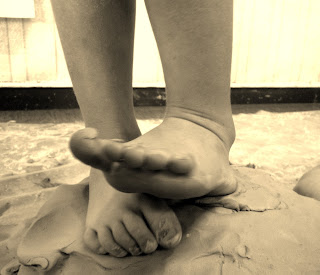Clay comes from the earth: ancient, organic, substantial. It smells cool and dark. It is made from rock that has been transported far from its original source. It occurs in seams or beds which are often near a body of water.
Clay requires muscle. We engage with clay with our skin and because it comes from the earth, playing and working with clay grounds and connects children to the earth and nature.
Over the past two weeks we have chosen to offer our children full-body exploration with clay. This thinking was inspired by two schools of thought, one being that we have many new children who may not have had previous experiences with clay and the second was the writings of master teacher Ann Pelo.
Ann emphasises that full-body exploration allows children to develop a relationship or friendship with clay. And that understanding clay’s identity is essential prior knowledge to using it as an art medium.
“As children bring their whole body to the experience of clay, they experience the responsiveness of the clay. This first encounter, body to body, begins the dialogue between children and clay” (Pelo, 2007)
Inspired by Ann’s writings, we re-set up our clay space by removing the table and replacing it with a large plastic tarp on the floor. Next we set out a new clean block of white porcelain clay.
This large block invited lots of curious participants; why was it on the floor? What could be done with it? And we responded; we are going to explore this with our whole bodies!
Tentative first movements of curled toes and pressed in fingers soon gave way to exuberant pounding and jumping. This block could hold the children’s weight yet with lots of physical activity could be slowly moulded towards the floor.
As the children played we offered words to invite further investigation; I wonder what knees do to clay? Look what happens under your jumping feet, what happens if you press in your elbows?
“Each child is unique and the protagonist of his or her own growth. Children desire to acquire knowledge, have much capacity for curiosity and amazement, and yearn to create relationships” – Loris Malaguzzi
With a morning of pounding and exploration the clay soon became wide and flat like a pancake which offered new possibilities for rolling and reforming a mound and invited team work and collaboration, as flattened clay is also heavy!
After two weeks of exploration our clay is now back on the table and being offered in large lumps. As teachers we have valued observing Ann’s writing’s un-fold into real experiences. Many of the children have thoroughly loved the opportunity to explore the clay with their whole bodies, which is a great reminder to us as educators to remember to take all learning back to its beginning at times.
As Maryann Kohl reminds us “Art is a process, not a product”
Nga mihi nui
Kim Townsend

















No comments:
Post a Comment